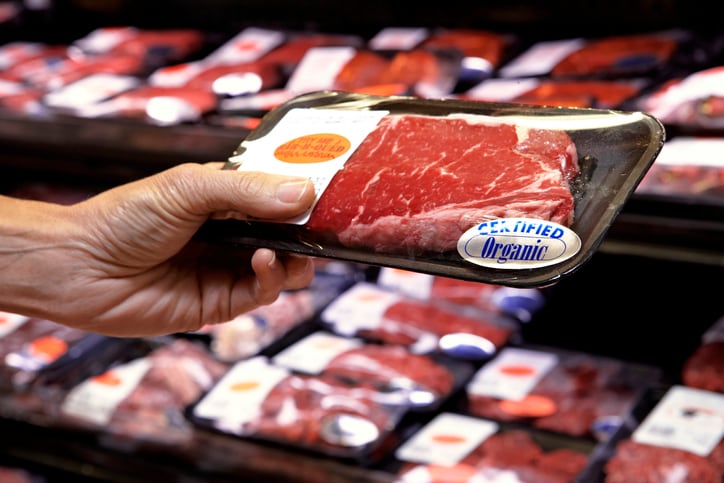The 16th annual “Power of Meat” report released last week reports retail meat department sales surged 19.2% in 2020 to $82.5 billion – a dramatic increase from 1% sales growth in 2019. While much of this growth can be attributed to a 7.4% increase in the price per volume of meat last year, volume still increased 11% in the period.
Much of this increase was driven by shifting habits during the pandemic, such as consuming more food at home, including lunch, which previously may have been eaten at school, the office, or on-the-go.
“More than three-quarters of shoppers changed something about their meat purchases during the pandemic,” according to the report. “Driven by dinner and lunch, 43% of shoppers bough more meat and poultry. Additionally, four in 10 shoppers bought differently, whether different types (42%), different cuts (40%) or different brands (45%). The biggest drivers of buying differently are looking for better value, cooking more meals and fewer store trips.”
The jump in retail meat sales and volume at retail comes even as many Americans say they are cutting back on their meat consumption and focusing on more plant-based diets.
According to the report, 19% of consumers now describe themselves as ‘flexitarians,’ who eat mostly plants but occasionally meat or poultry. This was up from 10% in 2019. At the same time, the percentage of people who describe themselves as meat-eaters fell from 85% in 2019 to 71% in 2021. In addition, 34% of shoppers say they want to reduce their meat and poultry consumption, but only 6% have committed to a vegetarian or vegan diet, the report notes.
“Given the skew in flexitarian eating toward younger shoppers, actively addressing their concerns and desires over eating meat is key for the future health of the category,” the report notes.
Health concerns top the list for reducing meat & poultry consumption
Of the 34% of shoppers who say they want to reduce their meat and poultry consumption (up from 28% in 2020), the top reason was concern about the healthiness of red meat and the presence of antibiotics or hormones, according to the report. It added that 28% of shoppers “put a lot of effort into making nutritious and healthful choices,” and moderation remained the most common health-focused meat tactic.
“Sharing information about the importance of meat/poultry in the diet and the strides the meat industry has made in the areas of sustainability, social responsibility and animal welfare may help flexitarians choose meat more often,” advises the report, which adds, “flexitarians are more likely to purchase claims-based meat, blended items and plant-based alternatives to address their desire for nutritious, sustainable and humanely-raised meat and poultry.”
Cost concerns breaks into the top five reasons to cut back
Looking to save money was another common reason for cutting back consumption of animal protein, according to the report which found the reason was cited by 30% of shoppers – a 14 percentage point increase.
According to the report, in the last year, 68% of shoppers looked for promotions across the store, and in-store signage touting cents-off discounts or buy-one-get-one free deals were favorites among consumers.
“Value as a driver of meat choices typically increases in importance during bad economic times. During the heights of the Great Recession the Power of Meat found that the price per pound in combination with the total package price drove meat decisions over appearance, nutrition and eat/time of preparation,” the report added.
Value-added solutions wanted
While price is important, it isn’t the only way shoppers define value. Many also are looking for time-saving and more convenient solutions, such as pre-marinated, pre-cut or pre-seasoned solutions.
“In 2016, 37% of meat shoppers purchased value-added meat and poultry sometimes or frequently. In 2021, this increased to 68% -- an increase of 31 percentage points,” the report noted.
It also point out a high correlation between interest in valued-added meat and products that blend animal- and plant-based ingredients.
Better education need for ‘better-for’ claims
Shoppers also increasingly sought “better-for” items, including those that claimed to be better-for-them/their family (72%), the planet (34%), farmers and workers (29%) and animals (27%).
The report found “a big educational opportunity” for meat producers to drive sales by talking about animal welfare and sustainability. For example, it noted that 44% of consumers think they are buying products from more humanely-treated animals but 40% were unsure. Similarly, 43% thought the livestock industry was taking steps to be more environmentally-friendly, but 37% were unsure.
The report also found that “more consumers want to hear about the provenance of the meat along with information on nutrition and animal welfare.”
Other production claims, such as grass-fed and organic, also helped drive sales.
Further reading:

